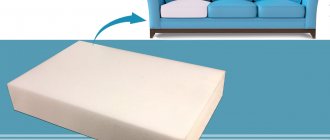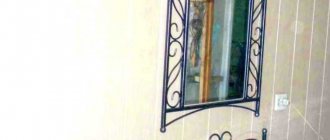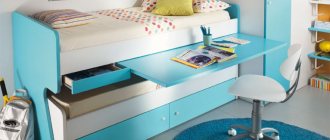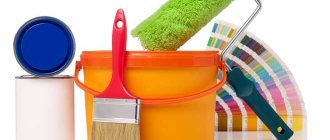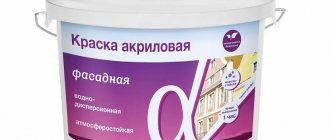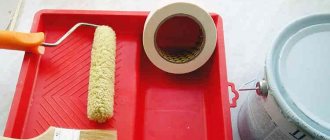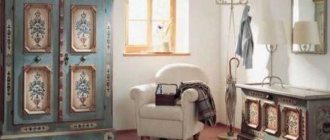Today, professional decorators and designers choose acrylic paint in their work. Having the advantage of paints of previous generations, it has a number of its own advantages, having lost the main disadvantages of oil paints and enamels.
Its main advantage is its ease of application, and you can not only repaint old furniture, but also carry out any decoration yourself.
Acrylic paint for furniture is environmentally friendly, odorless and has no harmful effects when used indoors. You can use it for children's rooms and be sure that it will not harm your child.
DIY redesign: how to repaint a cabinet in an hour
Have you ever experienced this itch in your hands and a strong desire to create something with that old wardrobe or chairs that you inherited and are an eyesore with their imperfections?
Or do you just understand that you want changes, but you’re not ready to invest in a complete replacement of the interior?
There is a solution: take a close look at the items you want to update, come up with a concept and go to the store.
Because it’s very easy to take and paint furniture that you’re tired of!
how to paint furniture
Repainting old and worn-out furniture can solve several problems at once:
- refresh the interior (which is logical);
- combine disparate objects into a single ensemble (for example, if you are a young family, and the only furniture you have is what you inherited, or else, in your dacha, individual objects from different eras often accumulate that need to be somehow made to work together);
- give vent to your creative energy (the most important thing, I think).
Well, if you do everything right, then no drama will happen, even if you don’t like the result - you’ll just choose a new shade and can paint the furniture again when you have a couple of hours of free time again.
Color selection
Look carefully at the item and think about where exactly you want to fit it - the choice of color depends on this.
You can choose a shade that contrasts with the main color scheme (for example, in a room with a beige-warm palette, you can put a table painted bright blue - it will enliven the interior with a color accent), or neutral (for example, you can paint an old table and chairs in white color, and place a beautiful vase with bright flowers on it).
Paint selection
Go to the largest hardware store nearby, catch the manager and explain the task - you need a universal paint that is suitable for painting wood, plastic and varnished surfaces (such exist).
You can choose the shade right on the spot if you have a rough idea of what you want. Although you can paint furniture with different colors, you will need the help of a specialist to understand what is best for you:
- Latex paints (they are the easiest to find, many different shades and relatively inexpensive), the downside is that before application you will need to spend time preparing the surface (clean it properly using solvents and sandpaper), which in itself eats up a lot of time.
- Chalk paints are a real hit in furniture painting; they do not require special preparation, apply well even if you are a neophyte, and mask application flaws and surface unevenness. Most of the pictures you see on Pinterest are painted with these paints, but they are harder to find (although you can buy anything online with delivery). Chalk paint adheres well and spreads out without leaving brush marks.
- Acrylic paints are the oldest and most proven way to repaint something. They apply well and the brush mark spreads out as the paint dries. But at the same time, they give a slight shine and the effect of “painted wood”, while chalk paints look more organic.
In addition to paint, you'll need brushes, tape to protect areas you don't want to paint, plastic wrap to protect the surrounding interior, sandpaper to prep surfaces, and wax to polish furniture that's already been painted.
Recommendations for working with paint
To work with acrylic paint, it is better to use synthetic brushes. Acrylic dissolves in water, and brushes and palettes are washed with water. After drying, acrylic becomes insoluble and can ruin brushes if they are not thoroughly washed immediately. When this is not possible during work, let the brush be in a jar of water. After finishing your work, be sure to wash and dry your brushes.
When painting old furniture with your own hands, it is important to know that dried acrylic cannot be removed with water; it can hardly be scraped off and sanded.
Recommendations for working with acrylic paint:
- If you stain your clothes, the paint must be washed off immediately, before it dries, by rinsing the fabric in plenty of water.
- After work, you should tightly close the tube or jar, otherwise the paint will dry out. Pre-clean the neck of any remaining paint so that you can open the package without effort next time.
- Once applied to the surface, water evaporates from acrylic paint and it becomes frost-resistant. But leaving paint packaging (cans and tubes) at subzero temperatures is strictly prohibited; the paint will deteriorate, losing all its properties.
COLORING
If you choose tinted paint, shake the can well before opening it - sometimes the pigment settles to the bottom. Give yourself time to take your time and really get to grips with how to apply the paint.
If you have chosen a paint that requires surface preparation before application, then do not skip this step. You can clean the surface using sandpaper (take 220 grit, it is universal).
If you've never painted anything before, practice on some old stool first, or buy something cheap and practice on it before you mess up your closet. You will always have time to paint the furniture; it’s better to get your hands on it first.
If you do not have experience, then you should not start with painting shelves - it is difficult, because you need to paint all surfaces (and the corners - this is the most unpleasant) evenly. Leave them for last, when you have a repainted chest of drawers and a couple of chairs behind you.
Never start painting an item from the main surface, always start painting from the back wall or lower surfaces to give yourself the opportunity to “shoot in” and stop if you absolutely don’t like the shade.
Use flat, wide brushes rather than rollers - on uneven surfaces with texture (wood), a brush works better, as it paints all the depressions and cracks.
Most paints require reapplication - after the first coat has dried, apply a second one, so brush marks will become invisible and the color will be more even. Chalk paints are quite dense, and sometimes one layer is enough, look at the result.
When you paint one side of an object, periodically check to see if drops of paint have fallen on other sides. For example, you are painting the side of a cabinet, and droplets of paint may fly away and settle on the already painted doors. Your goal is to prevent them from drying out, so just periodically inspect other surfaces. If you see telltale drops, just brush over them; when the paint dries, there will be no traces left.
And don’t forget about the final stage – polishing with special waxes for furniture. Wax will not only give things a new glossy look, but also protect surfaces from stains and scratches.
Types of paints and varnishes for furniture
Composition of paints
To understand how one type of product differs from another, and which paint and varnish materials are better to buy, you need to understand their composition. Any paint includes the following components:
- Water or solvents: this is the basis of paintwork materials, the viscosity of the composition, the presence or absence of odor depends on it.
- Binders: These are solid substances that create a film on the surface after the liquid evaporates. These components determine parameters such as adhesion, moisture resistance and wear resistance.
- Dyes and pigments: These are the particles responsible for the final color. The resistance of the composition to the negative effects of ultraviolet rays also depends on them.
- Additives and fillers: these are substances that enhance certain characteristics of paintwork materials and facilitate the work process. These components do not have coloring properties and are intended to give the product the required properties. This group includes a variety of waxes, stabilizers, and emulsifiers.
Types of paints for furniture
A modern manufacturer offers a wide range of finishing materials for interior items: expensive and budget, popular brands and new items. Many people buy the first product they come across because they do not understand which product is better to buy and what they should pay attention to. To avoid mistakes when choosing and not to spoil the product, you need to have at least a small idea of what types of paints and varnishes there are for furniture.
Acrylic
The binder in such compositions is acrylic polymers. According to buyers, these mixtures are the most harmless and affordable; they are often used in kindergartens and schools. However, you should know that the finished coating always comes out with a slight gloss, so this product is not suitable for some decoration methods.
Advantages:
- quick-drying;
- convenient to use, easy to apply;
- resistant to sunlight;
- quite dense, hides minor defects well;
- rich coloring;
- economical;
- does not require finishing coating.
Flaws:
- short-lived, wears off quickly;
- preliminary grinding of the surface is required;
- Not recommended for use on metal surfaces without primer.
Latex based
Coatings containing artificial latex are a popular solution for processing furniture. They easily penetrate the structure of a porous surface, forming a waterproof shell.
Advantages:
- durability;
- various colors;
- easy to apply;
- economical use;
- reasonable price.
Flaws:
- does not hide defects;
- cracks due to drafts and temperature changes;
- Before use, additional surface treatment is required to remove bacteria and mold.
Water soluble
Water-dispersed coatings are a common group of products used for a variety of interior work. They are produced on a water basis and also contain polymers and binders. As the applied layer dries, the liquid evaporates, and a durable polymer film is created on the surface.
Advantages:
- good adhesion;
- non-toxic;
- no strong odor;
- dries quickly;
- can be diluted with water.
Flaws:
- not intended for metal surfaces;
- cannot be used at low temperatures;
- when frozen, it loses its properties;
- fragility of the coating.
Transparent
The modern market offers a variety of transparent products: impregnations, glazes, waxes, stains, varnishes. They can be either colorless or containing pigments.
Advantages:
- good vapor permeability, allowing the material to “breathe”;
- emphasize the natural beauty of wooden surfaces;
- protect against UV radiation, destruction and aging;
- can be used both indoors and outdoors;
- There is no need to remove the old layer before application.
Flaws:
- Suitable only for wooden products;
- preliminary surface preparation is required (priming and sanding);
- takes a long time to dry;
- toxic, have a pungent odor that does not disappear for a long time;
- several layers are required;
- high consumption, since wood intensively absorbs the product.
Organic
The paints are based on organic solvents. Representatives of this group are polyurethane, oil and alkyd enamels. In the past, inexpensive organic compositions were quite popular, but gradually consumer interest in them faded due to the huge variety of new and modern coatings. Currently, the functionality of organic paints is limited mainly to exterior decoration and work at industrial facilities.
Advantages:
- affordable;
- has high water-repellent properties and can be used in rooms with high humidity.
Flaws:
- toxic;
- long drying time;
- fire hazard;
- has a strong unpleasant odor;
- the film does not allow air to pass through.
Silicone
Silicone options are significantly superior to all other types of coatings in properties and characteristics. Such compositions include water, organic elements, resins, and sometimes acrylic copolymers. These products are intended mainly for facade work, but they are also quite suitable for finishing interior items, especially wooden ones. It is advisable to use silicone emulsions to treat products located in rooms with high humidity.
Advantages:
- good vapor permeability;
- durability of the coating;
- resistance to biological and mechanical influences, UV radiation;
- water resistance;
- ability to hide significant irregularities;
- versatility, suitable for almost all materials;
- dirt-repellent properties.
Flaws:
- high price
Painting a dressing room cabinet with chalk paint Paint
There was an old wardrobe bought by the Minister of Culture in 197, then transferred to a friend, from a friend (my uncle), to my aunt, and then this wardrobe came to me almost forty years later)))
The label has been preserved. You can understand from it that this utility cabinet was purchased for 27 rubles in 197.
He came to me little old and shabby. The old handles were torn down, although new ones have not yet been purchased, but this is a matter of time. They washed and sanded, although without trying, because... We decided to paint it with chalk paint. I made the paint according to the recipe of the wonderful craftswoman of our site Oksana Panina: 1 part acrylic paint, 1/3 part chalk, 1/3 part water. And be sure to strain the paint.
We tried to paint with a brush (we couldn’t find a bristle brush, as Oksana P. advised). Stains remain, even if the paint was diluted thinner. So the rest was painted using a roller. Judging by the photo, even after the first layer of paint, all this unsightly beauty was hidden, because... The hiding power of this paint is strong.
Mixing acrylic paints: table and rules
When painting furniture with acrylic paint, you can immediately buy paint of the required color or shade. Or you can learn how to mix acrylic paints yourself by purchasing only the base white color. But to paint and decorate furniture, you will in any case have to mix the paints yourself to achieve the desired tone.
Let's look at the rules and the process of mixing acrylic paints using the example of obtaining ivory paint. The volume of the mixture components is indicated conditionally so that the proportions are clear. It is impossible to give an exact recipe, since each manufacturer of artistic paints has its own color saturation of pigments, and paints with the same name rarely match in color.
To mix, take paints: white 96%, light ocher 2%, cadmium yellow 1%, lemon 1%.
- Start mixing, gradually introducing ocher into the white with a brush, then all the other colors.
- While mixing, do color tests on a sheet of white paper.
- Based on the samples you have made, gradually add white paint or other components of the batch.
- Experiment with the ingredients, achieving different shades, but do not forget that acrylic paints darken after drying, changing tone.
When mixing paints yourself, use burnt umber instead of black paint to create more organic, subtle dark shades.
Below is a visual table for mixing acrylic paints with which you can easily experiment and create new colors:
Method 1: Painting the kitchen with chalk paint
Do you want to update your kitchen set beyond recognition with your own hands? The best way to do this is to repaint the facades with chalk (mineral) paint. Why chalk?
- The fact is that this type of paint has a thicker consistency and increased adhesive properties, due to which it fits perfectly on any surface - even on laminated chipboard/MDF. Moreover, chalk paints eliminate the need for tedious sanding and sometimes even without primer.
Chalk paints are also good because they give the painted surface a texture similar to that obtained when painting a wooden surface. Therefore, even the most ordinary kitchen with film facades will look much more noble after such an “update”.
- In Russia and the CIS countries, you can buy chalk paints from designer Daria Geiler, foreign manufacturer Annie Sloan, Kazakh Vernenskaya Manufactory, etc. You can also make chalk paints yourself using recipes that are easy to find on the Internet.
Here are some photo examples of kitchens before and after restoration.
Photo of a kitchen with film facades before and after painting with Daria Geiler paint. Here the author of the alteration restored the peeling film on the facade near the stove, and then painted the furniture without removing or sanding the film
Parameters and characteristics
The paints have a huge variety of parameters - some of them are odorless, which allows them to be used in a child's room, while other types cover the particle structure. There are quite a few nuances when it comes to choosing paints:
- Acrylate paint is characterized by the fact that it is diluted with water, while the material has fairly good adhesion. Is it possible to paint chipboard with acrylate paint? - Can. It is just as suitable for this as alkyd. After painting, they form a film with high-quality adhesion. The material itself is wear-resistant;
- Primer paints are applied under finishing paint. The point of applying it is to connect the working surface and finishing paint;
- Latex paints are diluted with water and dry very quickly;
- There is also a classification of base paints. Base A contains paints used to produce light colors. Base C includes the products used to produce dark colors. Toning pastes must be added to them. The EP base includes wood protective varnishes and wood stains.
Solvent-free latex paint can be found on sale. Using it will mean there is no need to REMOVE THE PAINT SMELL. It can be used for a room where children or allergy sufferers live.
Special terms may be used when using furniture paint. Normal conditions usually mean an air temperature of about 23 degrees and air humidity of about 50%. To understand whether it is possible to paint chipboard furniture with a specific type of paint, you need to decide whether this furniture will need to be washed - wash-resistant compounds do not change their properties even after intensive washing. As for thixotropy, this paint is well leveled on the working surface.

